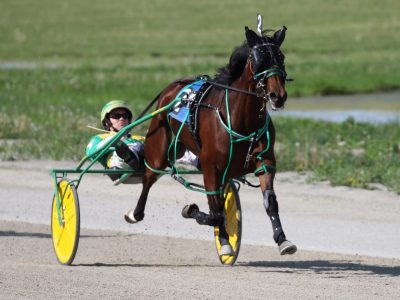By John Furgele
Harness racing had another good year. Handle was up, wagering per race was up, and the top pacers and trotters performed admirably, as usual.
With 2021 in the books, we’re moving forward with some forecasting and setting goals for the new year.
Here’s my wish list:

Harness Racing History: First Pacing Mare Wins Horse of the Year
Sports move fast with lots of action. And, with so many betting options, it requires attentiveness. Harness racing, however, continues to move at a slow pace. Why? Does the sport lack young, energetic people with fresh ideas? Or has it adopted the “it is what it is” mentality and because of that refuses to change?
How about more fixed-odds betting? In the old days, when gambling was illegal everywhere but Las Vegas, fixed odds betting was not allowed. In horse racing, you’re betting against the other bettors. The only thing the “house” did was set the morning line odds, leaving it to us to set the final odds and because of that, it was a legal endeavor. The house gets some money for processing, but the rest is divided up among the bettors.
How many times do you really like an 8-1 shot, but right before the gate rolls away, the horse ends up 4-5? Now, instead of winning $45 on your $5 bet, you’re only cashing $9. Other sports allow it, why can’t harness racing? Let me lock into the rate I want and then see what transpires. And the reverse can also happen. You may lock in at 8-1, and at post time, the horse may be 12-1.
Horse racing will always be a pari-mutuel sport but offering more betting options for those willing to wager is never a bad thing. Fixed odds can help provide that and we’ll also see which handicappers really know their stuff, adding more intrigue.
Shorten the race card
End the five-hour race card. On Sunday (Jan. 2), Northfield Park carded 16 races. The first went off at 6:08 p.m. ET; the last 11:48 p.m. That’s five hours, 40 minutes for 16 races that take about 32 minutes to race.
Is that a progressive approach? The reasons are simple they say — we need to spread things out because there are other tracks racing; we need to give bettors time to make exotic bets; we need to maximize every betting opportunity.
Those are valid points, and because most of the betting is done off-track, what’s the harm? That said, if you want people to invest in the sport, to like the sport, to want to attend in person, speeding things up is paramount. For some reason, those that run racetracks think longer is better, but if you look at the numbers, that’s not the case. At places like Yonkers, the longer the card, the less is bet. At some point, they tune out and move on, sometimes, to bed.
Bettors will adjust. Those that study the cards will do so with more intensity, knowing that they don’t have 20 minutes — or more –between races. With newer people, the faster paced action might make them want to come back to the track a second, third or fourth time. Why can’t a race finish and one minute later, the field for the next race get on the track and get ready to go. Why can’t we have five races per hour?

Sandbetweenmytoes – Photo Courtesy of U.S. Trotting Association website
Ditch the 0 MTP (minutes to post)
Next up, post drag, the evil act of showing 0 MTP for 10 minutes; that also needs to end. We know why it happens. Because tracks seldom coordinate with each other, they don’t want two races going off at 8:13 p.m. To prevent that, they will drag out the start. One track will go at 8:13 p.m., while the other lets the horses prance around for another six or seven minutes in hopes people will bet both tracks rather than one. They wouldn’t do this if there wasn’t some benefit, but the optics are bad and most likely, does more harm than good. Harness racing certainly didn’t create post drag, but they’ve made it an art form. It’s among the top things that fans want fixed. Some tracks are trying, we need them all to.
Speed it up
Let’s look at Northfield’s Jan. 2 card. Race 1 went off at 6:08 p.m.; race 2, 6:34 p.m.; and race 3 at 7 p.m. That’s 26 minutes between races, enough to make some thoroughbred tracks blush. There simply is no reason to only race two or three times per hour. From 10-11 p.m., two races were run, meaning that in that 60-minute block, there was 56 minutes of — nothing.
Some think that if casino revenue is taken away from harness racing that the sport will die a slow and painful death. Whether that happens remains to be seen, but if it did, having two races in 60 minutes will slam the lid on the sport.
Harness racing, much more than thoroughbred racing, needs daily action and faster action. One thing harness racing hung its collective hat on was more races per card in less time. Is that still the case today? When I was kid watching races at Buffalo Raceway, it seemed like the races were one right after the other. Let’s race every 15 minutes and see if handle increases?
Why can’t Northfield card 12 races and get the card started at 6 p.m. and be done by 8:30 p.m.? At the very least, try it. It would need to be marketed and that’s tough because most tracks have skeleton marketing departments and horsemen scream when potential purse money is used on things other than purses, but we need the sport to get with the times. Let’s move the program along; less is more and less time at the track might be good for all.
Of course, drug reform is needed
The sport, like most others, needs meaningful drug reform. Sadly, every time drug legislation is introduced, it’s opposed by the United States Trotting Association and its president, Russell Williams. He cites inconsistencies between the states, and he’s not wrong. However, it’s more than likely that without drugs (legal or illegal), it would be tough to have full fields. It is harness racing, after all, that gave us the ‘Beard Trainer,’ trainers that get banned but turn their operations over to their spouse, son or daughter and things just go on like normal. The banned trainer keeps training, with his loved ones serving as the shield.
We have trainers under federal indictment that are banned from racing at some tracks but are welcomed at others. What message does that send to bettors? We have seen a horse pace a 1:59 mile, get claimed by a shady trainer, and in two weeks, they pace one in 1:52. Are we fooled?
Hey USTA, address the drug issues
Williams and the USTA make their money by having horses race and that is something I respect, but what I’d like to see is their idea for reform. Instead of issuing statements opposing reform, why not counter; why not offer something tangible, something workable that could serve as a starting point for some meaningful conversations?
The USTA needs to do better. Educate the politicians, work with legislators, and produce a program that has some teeth and is practical. The sport would benefit and moreover, it could quell an already skeptical public (thoroughbred racing comes in here with the sudden death of Medina Spirit, the 2021 Kentucky Derby winner who could be disqualified following a positive post-race drug test).
These are a few areas that could use attention in 2022 and beyond. The idea is to make the sport as safe as possible and regain the trust of the fans, the people who make their wagers that support the industry.

As a kid growing up in the Buffalo suburbs in the 1970s and 80s, the radio was one of John Furgele’s best friends. In the evenings, he used to listen to a show on WBEN radio called “Free Form Sports,” hosted by Buffalo broadcast legend Stan Barron. The show ran weeknights from 6 to 11 pm and featured every kind of sport you could imagine. One minute, Mr. Barron was interviewing a Buffalo Sabres player; the next, he was giving high school field hockey scores.
But there was always one thing that caught John’s ear. During those five hours, Barron would give the results from Western New York’s two harness racing tracks — Buffalo Raceway and Batavia Downs. This is where John learned what exactas, quinellas, trifectas and daily doubles were all about. From then on, he always paid attention to harness racing, and when Niatross (a legendary Western New York horse) hit the scene in 1979, his interest began to blossom.
John believes harness racing is a sport that has the potential to grow and he will explore ways to get that done via marketing, promotion and, above all, the races themselves.
When he’s not watching races, John is busy with his family and his job in sales. Like the pacers and trotters, he does a little running himself and you’ll occasionally find him “going to post” in a local 5K race.


